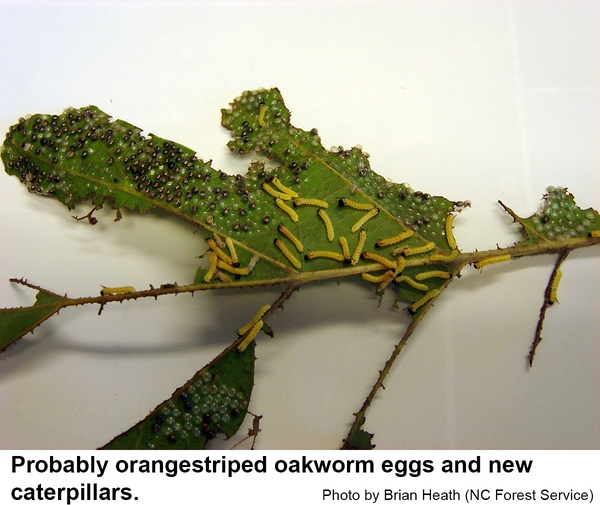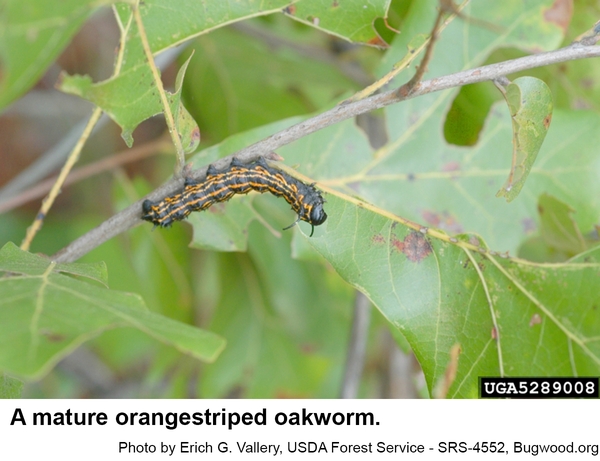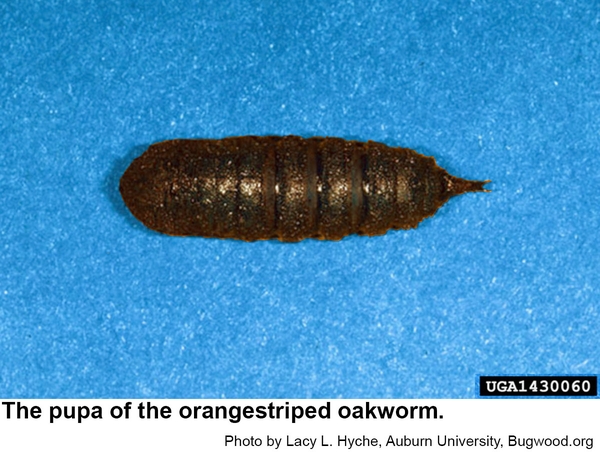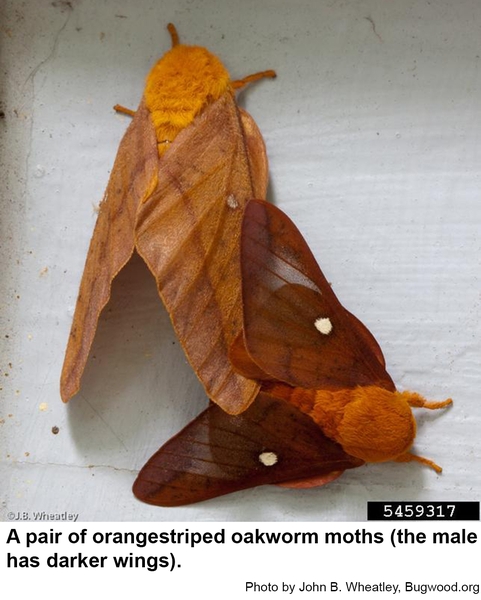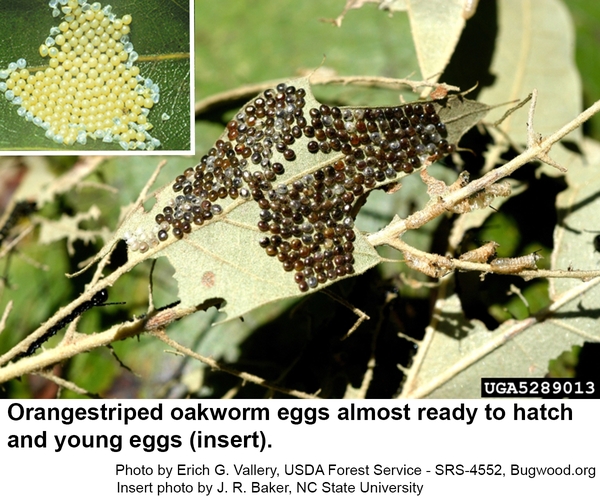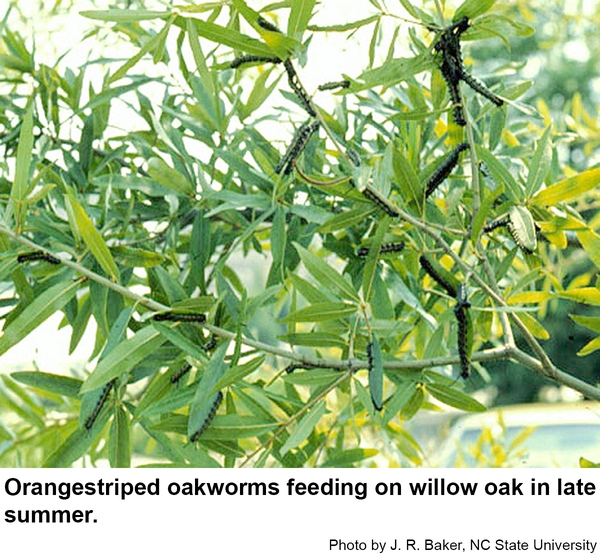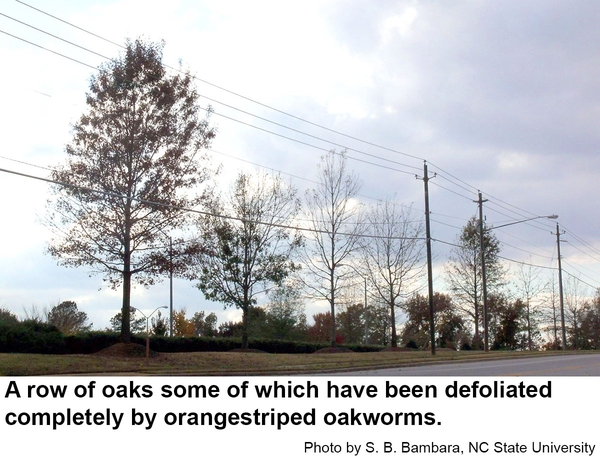Description and Biology
Orangestriped oakworms, Anisota senatoria, are sometimes very abundant on oaks in late August and September (they occasionally feed on other hardwoods as well). The moths emerge in June and July and females deposit up to 500 eggs in clusters of several hundred on the underside of oak leaves. The moth is brown with a white spot and a dark stripe on each forewing. Male moths are smaller and have darker but somewhat transparent forewings. The eggs hatch in about a week or so. The tiny, greenish caterpillars eventually grow into splendid, black worms with yellow stripes running lengthwise along their bodies. These caterpillars have a prominent pair of spines or slender horns sticking up behind the head. Young worms feed in groups, whereas older worms tend to be solitary although there may be thousands of caterpillars on a single tree. Small trees are sometimes defoliated completely by mid summer. Even mature oaks are sometimes defoliated to the point of twig dieback due to sun scald or other factors. These caterpillars excrete dark, dry pellets of frass. The larger worms produce many relatively large pellets that rain down from infested trees. As the worms mature, they are often seen crawling along sidewalks and driveways and yards. These caterpillars may wander for a considerable distance while searching for a place to pupate. They dig into the soil three or four inches and pupate there. There is usually one generation per year, and the worms overwinter as pupae in the soil.
Host Plants
Orangestriped oakworms are most often associated with oaks although they have been collected from other hardwoods including birch, hazelnut, hickory and maple.
Residential Recommendations
Control is often complicated by the size of many infested trees. Although small orangestriped oakworms are susceptible to most of the insecticides labeled for home landscape use, most amateur horticulturists do not have sprayers that can reach far up into shade trees where the caterpillars are feeding. By the time the caterpillars descend and crawl about on the soil, they are extremely resistant to pesticides. Fortunately, late summer defoliation is much less damaging to the health of trees than early spring defoliation. In mid to late summer, it is probably better to rely on birds, predators such as paper wasps, diseases, and parasites to lower the population for the next year. In case a tree is small enough to treat, for organic control, use one of the Bacillus thuringiensis or neem extract pesticides but only if the oakworms are young. For mechanical control, knock the caterpillars off the trees and trample them under foot if possible. Shaking limbs with a pole or by rope can cause the caterpillars to drop to the ground. If the tree trunk is small enough, you may be able to thump on the trunk enough to create a rain of caterpillars! (Cover your head!) If orangestriped oakworms are a perennial problem and you are adventuresome, try enhancing the predator population by installing wasp nest boxes nearby next spring.
Other Resources
- Identification and Management of Orange-striped Oakworm. Siegert, N. W. and D. G. McCullough. 1998. Michigan State University Extension Bulletin E-2654. 2 pp.
- Orangestriped Oakworm Anisota senatoria, Saturniidae. HIskes, R. No date. Connecticut Agricultural Experiment Station.
- Orangestriped Oakworm (Anisota senatoria). Anonomous. © 2024. Landscape Pest Management, UGA Extension
- Paper Wasps for Caterpillar Management in the Landscape. Frank, S. et al. 2000. Entomology Insect Note, NC State Extension Publications.
- Extension Plant Pathology Publications and Factsheets
- Horticultural Science Publications
- North Carolina Agricultural Chemicals Manual
For assistance with a specific problem, contact your local N.C. Cooperative Extension center.
This Factsheet has not been peer reviewed.
Publication date: Aug. 9, 2023
Reviewed/Revised: Sept. 2, 2025
Recommendations for the use of agricultural chemicals are included in this publication as a convenience to the reader. The use of brand names and any mention or listing of commercial products or services in this publication does not imply endorsement by NC State University or N.C. A&T State University nor discrimination against similar products or services not mentioned. Individuals who use agricultural chemicals are responsible for ensuring that the intended use complies with current regulations and conforms to the product label. Be sure to obtain current information about usage regulations and examine a current product label before applying any chemical. For assistance, contact your local N.C. Cooperative Extension county center.
N.C. Cooperative Extension prohibits discrimination and harassment regardless of age, color, disability, family and marital status, gender identity, national origin, political beliefs, race, religion, sex (including pregnancy), sexual orientation and veteran status.

